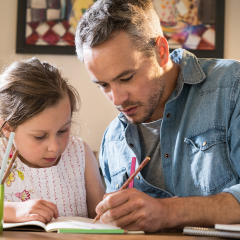Research Findings
It has been widely reported that the education of disadvantaged pupils has been more adversely affected during the Covid pandemic than that of their peers. Now pupils have returned to the classroom, leaders are making decisions about how best to support pupils, particularly those from disadvantaged backgrounds.
A recent Pisa study compared pupils from disadvantaged backgrounds who do well, with those who do not. It found that high-achieving disadvantaged pupils tended to use metacognitive strategies. The study recommended teaching programmes that support metacognition for disadvantaged pupils.
What is Metacognition?
Matt Bromley says, ‘Metacognition is actively monitoring one’s own learning and, based on this monitoring, making changes to one’s own learning behaviours and strategies.’
Metacognitive strategies are the strategies learners use to plan, monitor and evaluate their own learning. For example, when learning spellings for a test, a pupil might choose to ‘say words as they are spelt’. During the test, they notice a number of words use the -ssion and -tion spelling patterns. After the test, they decide to use both strategies to learn their spellings next week.
At the heart of metacognition, pupils are guided to make these decisions themselves. Of course, the decisions are not always effective (the pupils above may find that the spelling test the following week is on homophones) but pupils can use mistakes to improve their choices next time.
To be successful, pupils need to be taught a range of strategies to tackle tasks. These are the cognitive strategies. Metacognition happens when pupils reflect on which strategies were successful and what they might change.
To facilitate metacognition, lessons plans need dedicated time for pupils to decide what will help them next time they tackle a similar problem.
How Can We Develop Metacognition in Our Pupils?
In some ways, this is easy. Teachers already know and use many of the strategies to support pupils’ metacognition.
We all know the importance of activating prior learning, demonstrating where the learning sits within each unit or wider curriculum, reviewing the strategies pupils have in their repertoire and reflecting on the effectiveness of a chosen strategy. However, we have also all experienced lessons where the need to ensure content is covered is sometimes at the expense of reflection on how effectively pupils have learnt. This reflection is where pupils develop their metacognitive skills. It is where pupils review how well they achieve: where they have less success and what they might change or what works well and in which other situations might they use the strategy.
Jeavon Leonard suggests a seven-step teaching model which transfers the ownership of the learning from adult to pupil:
- Activating prior knowledge
This is where pupils retrieve previously learned strategies which are relevant to the task - Explicit strategy instruction
How to complete the task is explained - Modelling of learned strategy
An aspect of the task is modelled by an adult or peer - Memorisation of the strategy
The teacher checks that information has been understood and remembered, including in different contexts - Guided practice
Collaboration with peers to complete the task - Independent practice
Task is completed independently - Structured reflection
Collective and personal evaluation on what went well and when else this strategy could be useful as well as what didn’t go well and what could be done differently next time
As the ownership for learning is transferred above, the proportion of teacher talk reduces from approximately 90% to 10% whilst the proportion of pupil talk increases.
Pupils’ reflection on their learning through these seven steps is key to acquiring metacognitive strategies. The seven-step teaching model provides a structure to ensure pupils have the opportunity to reflect on their learning, but for many pupils, teachers need to guide pupils to do so.
Questioning is a useful tool to support pupils to develop their metacognitive skills. Different types of questions may support pupils at different points in the teaching sequence. At the planning stage (stages 1-3 above), consider asking questions such as:
- What am I being asked to do?
- Which strategies will I use?
- Are there any strategies which I have used before that might be helpful?
To encourage pupils to monitor their learning (possibly stages 4-6 above), pupils should be encouraged to ask themselves:
- Is the strategy that I’m using working?
- Do I need to try something different?
The part of the cycle which is key to pupils transferring their metacognitive skills, but which is often given least time is the evaluation stage (stage 7 above). Questions to consider might be:
- How well did I do?
- What didn’t go well? What could I do differently next time?
- What went well? What other types of problem can I use this strategy for?
Pupils will also benefit from seeing metacognition modelled. Teachers could model their own thinking processes when faced with a task by asking questions aloud such as ‘What do I know about problems like this? What ways of solving them have I used before?’.
For some pupils, sentence stems can support metacognitive talk and self-reflection in the classroom. Stems such as ‘… approach has helped me to understand …’ or ‘I’ve tried… and this isn’t working so what else could I try?’ can support pupils to talk together about their learning and eventually support pupils to reflect themselves.
Of course, for all these approaches to be successful, pupils will need to have been taught a range of cognitive strategies from which they can choose.
Next Steps
If you wish to further develop metacognitive strategies with your teachers or TAs, you may find the discussion points below useful:
- What does metacognition look like in our school?
- Do we teach metacognitive strategies in subject-specific contexts? How do we cement these as transferable skills?
- Which strategies do we teach to organise ideas, get started, evaluate success?
- How frequently do we share our own thinking (model) with pupils: ‘What do I know about problems like this? What ways of solving them have I used before?’?
- What is the balance of scaffolded tasks and withdrawn support so pupils can develop their skills and strategies before applying them independently?
- How do we promote and develop metacognitive talk in the classroom? Which language stems would support pupils to discuss their work?










